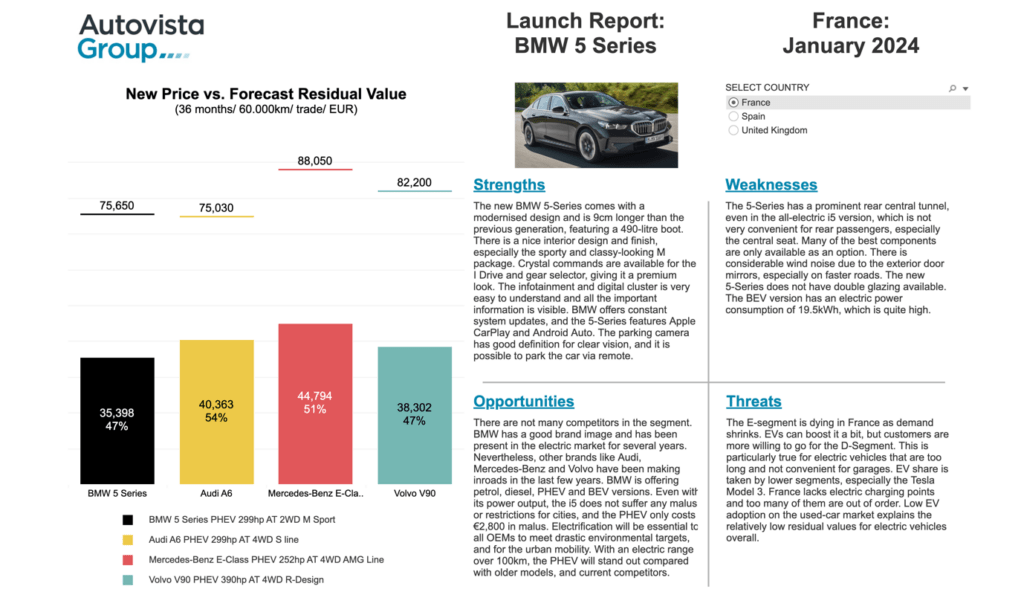Launch Report: BMW 5-Series retains prestige status
25 January 2024

Attempting to push the premium bar ever higher, the BMW 5-Series has a new look. The G60 generation is also accompanied by a battery-electric variant known as the i5, a first for the range.
Since its launch in 1972, the BMW 5-Series has entwined itself in the brand’s identity, providing a sense of accessible premium motoring. The sedan has remained a cornerstone of the carmaker’s line-up for the last 50 years, a testament to its performance and evolution.
Autovista Group experts from France, Spain and the UK analysed the model in their respective markets. The car’s strengths, weaknesses, opportunities and threats have been benchmarked against key rivals, with new-price points outlined alongside forecast residual values.
Modernising the 5-Series
The G60 generation builds on the work of its predecessors and introduces new BMW concepts to the 5-Series. For the first time, the car features a range of powertrains, including petrol, diesel, and plug-in hybrid (PHEV), as well as the i5 battery-electric vehicle (BEV) version.
However, with the popularity of diesel declining, BMW will not be launching this powertrain in some markets, such as the UK. It remains to be seen how this will impact sales, especially in fleet-driven markets. However, the PHEV and BEV variants may help pick up the slack.
The BEV version allows company car drivers to keep the luxury features of the 5-Series, while also benefitting from zero-emission technology. The i5 is also quite understated, designed with the same styling as its internal-combustion engine counterparts. This will likely appeal to drivers who dislike the modern styling of some BEVs.
Strong and traditional design
The car stands impressively on the road, utilising its exterior design to good effect. The new model is 9cm longer than its predecessor, resulting in a longer rear overhang. This is angled up towards the bumper, giving the impression the car is pointing forward, ready to go.
The long front end incorporates a smaller, more refined version of BMW’s kidney grille. This will please those who have argued that the trademark design has grown too large on other models in recent years.
There are other nice exterior design touches, such as the number ‘5’ etched into the panels behind the rear door windows. On the i5, fake grill louvres keep the brand’s design consistent while ensuring an aerodynamic BEV-based front end.
The interior includes BMW’s curved display, with the 12.3-inch digital cluster and 14.9-inch central display projecting around the driver. The door trims and high centre console provide a single-seater cockpit experience.
The carmaker has also included its crystal dial controls for the i-Drive, as well as the crystal gear selector in the centre console. This gives users of the new 5-Series a sense of prestige. Rear-seat passengers get two USB-C ports and a digital screen for the climate control system.
Practical, but problematic
When it comes to practicality, the BMW 5-Series benefits from a 490-litre boot, although as a sedan it can be more difficult to load when compared to a hatchback. There is plenty of storage space inside the car, especially in the long centre console, although the dual-door design can be restrictive.
The sloping coupe-style roof could hamper headroom for taller rear-seat passengers. The car also features a centre tunnel, even in the i5, which can restrict legroom, especially for those in the middle seat.
Overall, the new BMW 5-Series is an impressive car and builds on the model’s strong history. Its refined design and prestige feel will appeal to drivers wanting to make a statement on the roads, but in a traditional style.
View the Autovista Group dashboard, which benchmarks the BMW 5-Series in France, Spain, and the UK. The interactive dashboard presents new prices, forecast residual values, and SWOT (strengths, weaknesses, opportunities, and threats) analysis.




